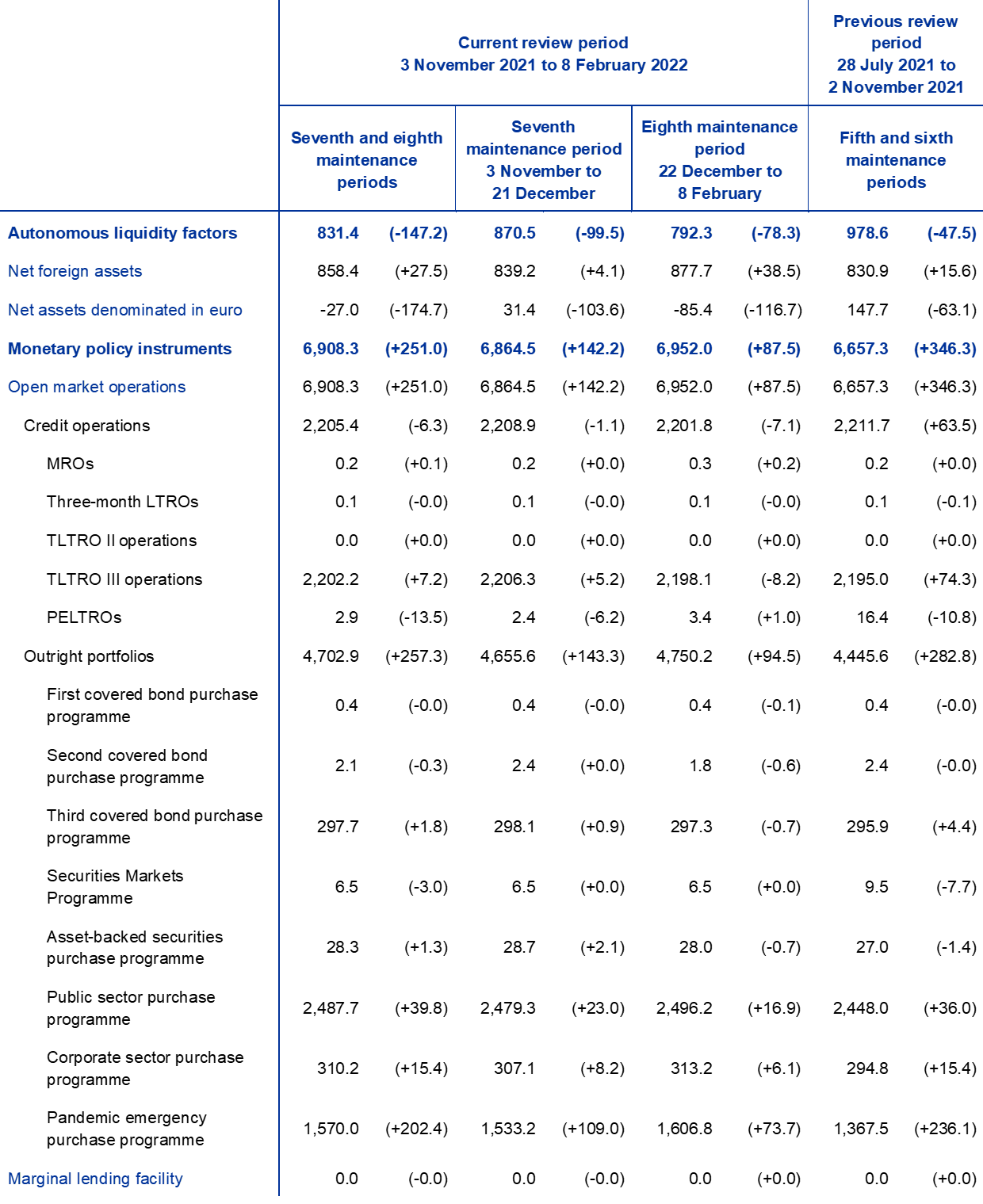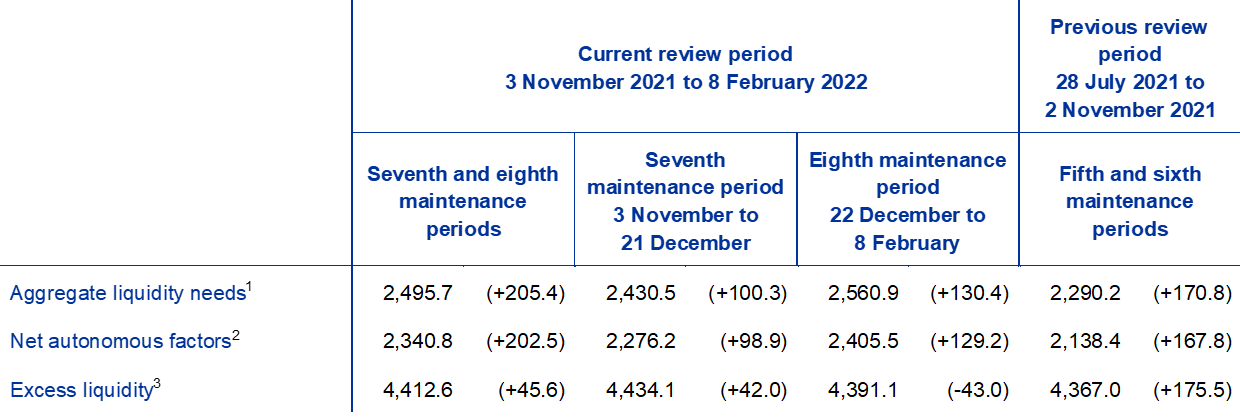Liquidity conditions and monetary policy operations from 3 November 2021 to 8 February 2022
Published as part of the ECB Economic Bulletin, Issue 2/2022.
This box describes the ECB’s monetary policy operations and liquidity developments during the seventh and eighth reserve maintenance periods of 2021. Together, these two maintenance periods ran from 3 November 2021 to 8 February 2022 (the “review period”).
Average excess liquidity in the euro area banking system rose by €45.6 billion during the review period, reaching a record level of €4,412.6 billion. This was due to asset purchases conducted under the pandemic emergency purchase programme (PEPP) and the asset purchase programme (APP). The effect of asset purchases on excess liquidity was partially offset by a sizeable increase in net autonomous factors. The TLTRO III programme had a net draining effect on liquidity for the first time.
Liquidity needs
The average daily liquidity needs of the banking system, defined as the sum of net autonomous factors and reserve requirements, increased by €205.4 billion to €2,495.7 billion in the review period. The increase compared with the previous two maintenance periods was almost totally due to an increase in net autonomous factors by €202.5 billion to €2,340.8 billion (see the section of Table A entitled “Other liquidity-based information”). Instead, minimum reserve requirements increased only marginally by €2.9 billion to €154.8 billion.
Liquidity-absorbing autonomous factors increased in the review period by €55.3 billion to €3,172.0 billion, mainly due to increases in other autonomous factors and banknotes in circulation. Other autonomous factors (Table A) increased in the review period by €76.4 billion to €1,035.8 billion. At the same time, banknotes in circulation increased by €27.3 billion to €1,531.0 billion. Government deposits remain at a high level despite decreasing by €48.3 billion to €605.2 billion, although this is well below the record high of €729.8 billion reached during the review period covering the fifth and sixth maintenance periods of 2020.
Liquidity-providing autonomous factors decreased by €147.2 billion to €831.4 billion. This decrease was the net outcome of a decline of €174.7 billion in net assets denominated in euro and an increase of €27.5 billion in net foreign assets. The decrease in net assets denominated in euro was caused to a large extent by the increase in the Eurosystem balance sheet item L.6 (“Liabilities to non-euro area residents denominated in euro”) on account of increases in Eurosystem Reserve Management Service deposits and securities lending operations against cash collateral with non-euro area counterparties over year-end. Balance sheet item L.6 reached €710 billion on 31 December 2021, the highest level ever recorded, as placing euro liquidity in the market over the year-end period became very costly.
Table A provides an overview of the autonomous factors[1] discussed above and their changes.
Table A
Eurosystem liquidity conditions
Liabilities
(averages; EUR billions)

Source: ECB.
Notes: All figures in the table are rounded to the nearest €0.1 billion. Figures in brackets denote the change from the previous review or maintenance period.
1) Computed as the sum of the revaluation accounts, other claims and liabilities of euro area residents, capital and reserves.
2) Memo item that does not appear on the Eurosystem balance sheet and therefore should not be included in the calculation of total liabilities.
3) Exempted and non-exempted excess reserves are explained on the ECB’s website.
Assets
(averages; EUR billions)

Source: ECB.
Notes: All figures in the table are rounded to the nearest €0.1 billion. Figures in brackets denote the change from the previous review or maintenance period.
Other liquidity-based information
(averages; EUR billions)

Source: ECB.
Notes: All figures in the table are rounded to the nearest €0.1 billion. Figures in brackets denote the change from the previous review or maintenance period.
1) Computed as the sum of net autonomous factors and minimum reserve requirements.
2) Computed as the difference between autonomous liquidity factors on the liability side and autonomous liquidity factors on the asset side. For the purposes of this table, items in the course of settlement are also added to net autonomous factors.
3) Computed as the sum of current accounts above minimum reserve requirements and the recourse to the deposit facility minus the recourse to the marginal lending facility.
Interest rate developments
(averages; percentages)

Source: ECB, RepoFunds Rate (CME Group).
Note: Figures in brackets denote the change from the previous review or maintenance period.
Liquidity provided through monetary policy instruments
The average amount of liquidity provided through monetary policy instruments increased by €251.0 billion to €6,908.3 billion during the review period (Chart A). The increase was the result of net purchases under the asset purchase programmes, primarily the PEPP, while maturing credit operations and TLTRO repayments drained liquidity.
Chart A
Evolution of liquidity provided through open market operations and excess liquidity
(EUR billions)

Source: ECB.
Note: The latest observations are for 8 February 2022.
The average amount of liquidity provided through credit operations decreased by €6.3 billion during the review period. The largest part of this decrease was caused by the maturity of pandemic emergency longer-term refinancing operations (PELTROs) in the previous review period, the effect of which only fully materialises in this period. Under the PELTRO, only €1.1 billion was allotted in the final operation in December 2021. Overall, the new PELTRO allotments and maturing tenders resulted in an average net liquidity absorption of €13.5 billion compared with the previous review period. The settlement of €51.97 billion in the tenth TLTRO III on 22 December was offset by voluntary repayments of earlier TLTRO III operations of €60.2 billion on the same date, so that, on a net basis, for the first time since their launch, TLTRO III drained liquidity. The main refinancing operations (MROs) and three-month longer-term refinancing operations (LTROs) continued to play only a marginal role, with average recourse to both of these regular refinancing operations remaining at record low levels, as in the previous review period.
Outright portfolios increased by €257.3 billion to €4,702.9 billion, owing to net purchases under the PEPP and the APP. Average holdings in the PEPP increased by €202.4 billion to €1,570.0 billion compared with the average for the previous review period. Purchases under the PEPP represented the largest increase across the ECB’s asset purchase programmes, followed by the public sector purchase programme (PSPP) and the corporate sector purchase programme (CSPP), with average increases of €39.8 billion to €2,487.7 billion and €15.4 billion to €310.2 billion respectively. The maturing of securities held in non-active programmes reduced the size of outright portfolios by €3.4 billion.
Excess liquidity
Average excess liquidity increased by €45.6 billion, reaching a new record high of €4,412.6 billion (Chart A). Excess liquidity is the sum of banks’ reserves above the reserve requirement and the recourse to the deposit facility net of any recourse to the marginal lending facility. It reflects the difference between the total liquidity provided to the banking system and banks’ liquidity needs. Banks’ current account holdings in excess of minimum reserve requirements grew by €58.5 billion to €3,673.0 billion, while average recourse to the deposit facility decreased by €12.9 billion to €739.6 billion.
Excess reserves exempt from the negative deposit facility rate under the two-tier system rose by €15.3 billion to €919.6 billion.[2] Non-exempt excess liquidity, which includes the deposit facility, increased by €47.1 billion, reaching €3,509.2 billion. The aggregate utilisation rate of the maximum exemption allowance, i.e. the ratio of exempted reserves to the maximum exempted amount,[3] which has remained above 98% since the third maintenance period of 2020, decreased marginally from 99.2% to 99.0%. The share of exempted excess reserves in total excess liquidity stood at 20.8%, compared with 20.7% in the previous review period.
Interest rate developments
The average €STR remained broadly unchanged at -57.6 basis points during the review period. As a result of the high level of excess liquidity, the €STR continues to be relatively inelastic, even in response to substantial fluctuations in liquidity. The EONIA was discontinued on 3 January 2022 and is therefore no longer reported. The ECB policy rates – the rates on the deposit facility, MROs and the marginal lending facility – were left unchanged during the review period.
The average euro area repo rate, measured by the RepoFunds Rate Euro Index, decreased by 15.6 basis points during the review period to -0.746%. This decline was unusually large and broad-based, affecting not only repo rates for transactions with German and French government bonds as collateral, but also those with Italian and Spanish government bonds as collateral. The decline can be attributed to end-of-year patterns, which were particularly pronounced. After following a steady downward trend in the earlier part of the review period, repo rates exhibited a very sharp drop on 31 December 2021, when the RepoFunds Rate Euro Index declined to its lowest level on record of -4.498%. In January 2022 this rate soon normalised and returned to close to the average for the seventh maintenance period.
- For further details on autonomous factors, see the article entitled “The liquidity management of the ECB”, Monthly Bulletin, ECB, May 2002.
- More information about the two-tier system for remunerating excess reserve holdings is available on the ECB’s website.
- The maximum exempted amount is measured as the sum of the minimum reserves and the exemption allowance, which is equal to six times the minimum reserves amount.


